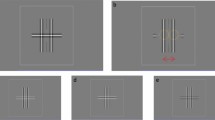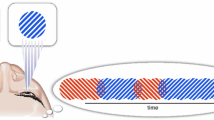Abstract
Both classical psychophysical work and recentfunctional imaging studies have suggested acritical role for the primary visual cortex(V1) in resolving the perceptual ambiguitiesexperienced during binocular rivalry. Here weexamine, by means of single-cell recordings andoptical imaging of intrinsic signals, thespatial characteristics of suppression elicitedby rival stimuli in cat V1. We find that the“interocular suppression field” of V1 neuronsis centred on the same position in space and isslightly larger (by a factor of 1.3) than theminimum response field, measured through thesame eye. Suppression is always strongest at asingle position corresponding very closely tothe centre of the classical receptive field,and reduces responses through the other eye byup to 90% but typically around 40%. Thespatial pattern of interocular suppression, asrevealed by optical imaging, closely matchesthe cortical representation of the stimulus,which is being suppressed, both in terms of itsorientation and the eye of origin. Theseresults indicate that interocular suppressionis directly related to the functionalarchitecture of V1; it is probably caused bydirect inhibitory interactions betweenneighbouring cortical columns of oppositeocular dominance.
Similar content being viewed by others
References
Blake, R., 1989: A neural theory of binocular rivalry. Psychological Review 96, 145-167.
Blake, R. andLema, S.A., 1978: Inhibitory effect of binocular rivalry suppression is independent of orientation. Vision Res 18, 541-544.
Blake, R.,O'shea, R.P. andMueller, T. J., 1992: Spatial zones of binocular rivalry in central and peripheral vision. Vis Neurosci 8, 469-478.
Blakemore, C., 1970: A new kind of stereoscopic vision. Vision Res 10, 1181-1199.
Blakemore, C.,Fiorentini, F. andMaffei, L., 1972: A second neural mechanism of binocular depth discrimination. J Physiol 226, 725-749.
Bonds, A.B., 1989: Role of inhibition in the specification of orientation selectivity of cells in the cat striate cortex. Vis Neurosci 2, 41-55.
Bonhoeffer, T. andGrinvald, A., 1996: Optical imaging based on intrinsic signals. The methodology. In A.W. Toga andJ.C. Mazziotta (eds), Brain Mapping: The Methods, London: Academic Press, pp. 55-97.
Braddick, O.J., 1979: Binocular single vision and perceptual processing. Proc R Soc Lond Ser B 204, 503-512.
Campbell, F.W.,Gilinsky, A.S.,Howell, E.R.,Riggs, L.A. andAtkinson, J., 1973: The dependence of monocular rivalry on orientation. Perception 2, 123-125.
DeAngelis, G.C.,Robson, J.G.,Ohzawa, I. andFreeman, R.D., 1992: Organization of suppression in receptive fields of neurons in cat striate cortex. J Neurophysiol 68, 144-163.
Hubel, D.H. andWiesel, T.N., 1974: Uniformity of monkey striate cortex: A parallel relationship between field size, scatter, and magnification factor. J Comp Neurol 158, 295-305.
Kisvárday, Z.F.,Tóth, E.,Rausch, M. andEysel, U.T., 1997: Orientation-specific relationship between populations of excitatory and inhibitory lateral connections in the visual cortex of the cat. Cereb Cortex 7, 605-618.
Lehky, S.R. andBlake, R., 1991: Organization of binocular pathways: Modeling and data related to rivalry. Neural Comput 3, 44-53.
Leopold, D.A. andLogothetis, N.K., 1996: Activity changes in early visual cortex reflects monkeys' percepts during binocular rivalry. Nature 379, 549-553.
Lumer, E.D.,Friston, K.J. andRees, G., 1998: Neural correlates of perceptual rivalry in the human brain. Science 280, 1930-1934.
Miller, S.M.,Liu, G.B.,Ngo, T.T.,Hooper, G.,Riek, S.,Carson, R.G. andPettigrew, J.D., 2000: Interhemispheric switching mediates perceptual rivalry. Curr Biol 10, 383-392.
Moore, R.J.,Spear, P.D.,Kim, C.B. andXue, J.T., 1992: Binocular processing in the cat's dorsal lateral geniculate nucleus. III. Spatial frequency, orientation, and direction sensitivity of nondominant-eye influences. Exp Brain Res 89, 588-598.
Ohzawa, I. andFreeman, R.D., 1986: The binocular organization of simple cells in the cat's visual cortex. J Neurophysiol 56, 221-242.
Polonsky, A.,Blake, R.,Braun, J. andHeeger, D.J., 2000: Neuronal activity in human primary visual cortex correlates with perception during binocular rivalry. Nat Neurosci 3, 1153-1159.
Sengpiel, F.,Baddeley, R.J.,Freeman, T.C.B.,Harrad, R. andBlakemore, C., 1998: Different mechanisms underlie three inhibitory phenomena in cat area 17. Vision Res 38, 2067-2080.
Sengpiel, F. andBlakemore, C., 1994: Interocular control of neuronal responsiveness in cat visual cortex. Nature 368, 847-850.
Sengpiel, F. andBlakemore, C, 1996: The neural basis of suppression and amblyopia in strabismus. Eye 10, 250-258.
Sengpiel, F.,Blakemore, C. andHarrad, R., 1995a: Interocular suppression in the primary visual cortex: A possible neural basis of binocular rivalry. Vision Res 35, 179-195.
Sengpiel, F.,Freeman, T.C.B. andBlakemore, C., 1995b: Interocular suppression in cat striate cortex is not orientation selective. NeuroReport 6, 2235-2239.
Sheinberg, D.L. andLogothetis, N.K., 1997: The role of temporal cortical areas in perceptual organization. Proc Natl Acad Sci USA 94, 3408-3413.
Sillito, A.M.,Grieve, K.L.,Jones, H.E.,Cudeiro, J. andDavis, J., 1995: Visual cortical mechanisms detecting focal orientation discontinuities. Nature 378, 492-496.
Sun, M. andBonds, A.B., 1994: Two-dimensional receptive-field organization in striate cortical neurons of the cat. Vis Neurosci 11, 703-720.
Tong, F.,Nakayama, K.,Vaughan, J.T. andKanwisher, N., 1998: Binocular rivalry and visual awareness in human extrastriate cortex. Neuron 21, 753-759.
Walker, P., 1978: Binocular rivalry: Central or peripheral selective processes? Psychological Bulletin 85, 376-389.
Wolfe, J.M., 1984: Reversing ocular dominance and suppression in a single flash. Vision Res 24, 471-478.
Author information
Authors and Affiliations
Rights and permissions
About this article
Cite this article
Sengpiel, F., Bonhoeffer, T., Freeman, T.C. et al. On the Relationship Between Interocular Suppression in the Primary Visual Cortex and Binocular Rivalry. Brain and Mind 2, 39–54 (2001). https://doi.org/10.1023/A:1017977500359
Issue Date:
DOI: https://doi.org/10.1023/A:1017977500359




